Chasing the Wild Epis
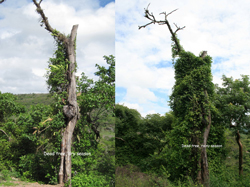 While browsing another website to get some pointers on growing "epis", I ran into to some interesting
comments. Several posters were stating their ideas of growing conditions in the "rainforest" to give them
some ideas as to how to care for their plants. Nice approach, but the obvious problem is that the whole tropics
is not composed of rainforest and isn't entirely on the equator!
While browsing another website to get some pointers on growing "epis", I ran into to some interesting
comments. Several posters were stating their ideas of growing conditions in the "rainforest" to give them
some ideas as to how to care for their plants. Nice approach, but the obvious problem is that the whole tropics
is not composed of rainforest and isn't entirely on the equator!
Nicaragua, for example, has many ecosystems, but tropical humid forest is but a small part of the country,
mostly in the far southeast. The northeast is mostly savannah, the northern mountains are tropical oak forest,
and much of the west is tropical dry forest. Soil types, rain, humidity, and sunlight vary in the extreme between
these areas, and these are only a few of the ecosystems.
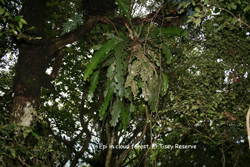 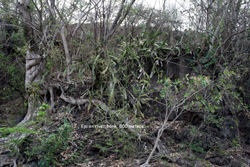
The first wild epis I found were near where I live in mid-elevation (850 Meters) dry forest. The climate is
moderate, with most days in the 70s and 80s Fahrenheit, and most nights in the 60s and 70s. UV radiation
can be intense. In this ecosystem, most rain falls from May to November, often in light showers but sometimes
in heavy rains that last for days. Localized flooding is common during the heavy rains. The dry season is
from November to May and will often have fairly high humidity but no rain. So, in simple terms, you have
half a year of jungle and half a year of desert. Day length also varies from summer to winter, but not as much
as in the more northerly parts of North America. The native plants are well adapted to this climate,
although many would never thrive in the heat and humidity of lower elevation humid forest, the "rainforest".
The plants in question were growing with their roots in the ground, but the plants clambering over large boulders. They
were in heavy shade because there are also trees growing in among the rocks. Almost always, there are also
split-leaf philodendrons growing with them.
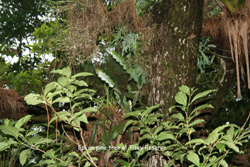
The soil type is a very heavy black clay mixed with rocks, certainly not what you would put in your hanging baskets.
The epis survive in their little niche, the boulders probably protection them from rot and the trees protecting
them from the sun. The philodendrons just happen to like the same niche.
The next epi I found was growing on a dead tree in full sun, which seemed strange on two accounts. Dead trees are
a rare occurrence because usually they would be chopped down for lumber or firewood and full sun seemed a
strange location for an epi. Well, when I came back during the rainy season at least half of the mystery was
solved: the epis were covered with herbaceous vines and were no longer in full sun. These plants also
appeared to be rooted in the ground and using the tree for support.
Finally, one day I was talking to a restaurant owner about an epi in his garden, later identified as E. oxypetalum,
and he told me of some other plants on a nearby hill. There I found, in a little patch of tropical oak-pine forest,
commonly called "cloud forest", what appear to be two different species growing on two different trees.
Again, they had their little niche. Had they been 20 to 50 meters away in any direction they would have been out of
the shade and would probably not have survived. This area is at about 1500 M and is often cool and damp, very
different from where I found the other epis. Both of these specimens seemed to be growing completely in the
trees with no roots in the soil.
Although I have been a lifetime cactus hobbyist, before encountering these plants I had zero experience with any
epiphyllum. They became a source of frustration when I realized that they cannot be identified without seeing
the flowers and fruits, and timing it just right to see this in the wild is nearly impossible. They bloom at
night, and in some cases only one night a year, and access during the rainy season can be problematic. So
recently I have redesigned my project on a more methodical basis. I am back tracking to all my epi sites
(9 at last count) and am taking pictures, gps readings, and cuttings. With a little luck, within 2 years or
so the new plants should flower and be identifiable. With species that grow quickly from cuttings or
seeds, this is the only way to proceed.
The surplus plants I can then donate to a local zoo and botanical garden who are interested in native plants
with proper scientific name and habitat location. I am also working with foreign and domestic botanists
on this project. The advantage that an amateur naturalist such as myself has is that I live here and
can check on the plants all year round, and digital cameras and the internet really make the process
easier. One can only think of people like Darwin and Cook who sent samples home by sailing ship and
had to wait months or years to find out if their samples arrived, were properly investigated,
and amounted to anything.
I am also growing out one type of Hylocereus in my yard to identify it, and a friend has given
me a location for a wild Disocactus, so my little science project will spread out to more than
just Epiphyllum. There are at least a dozen species listed for Nicaragua that I have not
yet identified, plus an unknown number of others that are not listed just because no one has
documented them here.
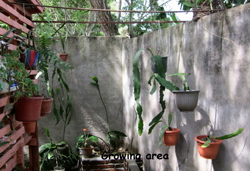
My shade house is due for an expansion!
Author: Leland Smith
|